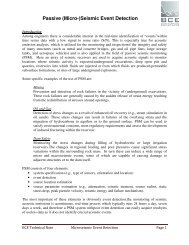SC3-RAV™ 2011 - Baziw Consulting Engineers Ltd.
SC3-RAV™ 2011 - Baziw Consulting Engineers Ltd.
SC3-RAV™ 2011 - Baziw Consulting Engineers Ltd.
You also want an ePaper? Increase the reach of your titles
YUMPU automatically turns print PDFs into web optimized ePapers that Google loves.
BCE <strong>SC3</strong>RAV <strong>2011</strong> Seismic Data Analysis Software<br />
Interval Velocity profiling) by putting<br />
check marks next to the values to be<br />
saved (all the results can be selected<br />
automatically be selecting the red check<br />
button) and selecting the graphical store<br />
data push button.<br />
The user can obtain estimates of the<br />
arrival times for each depth increment<br />
by enabling check box Display and<br />
Calculate Arrival Times as outlined in<br />
Figure 3. In this case, the user must<br />
first specify a reference arrival time and<br />
vertical depth (based upon the first<br />
break) for one of the seismic time series<br />
under analysis. The reference arrival<br />
time and depth values can easily be<br />
obtained by implementing the Depth<br />
Profile - Standard Display as outlined in<br />
section 3.2.1. For example, Figure 19<br />
illustrates a vertical seismic profile with<br />
the time series acquired at 4.0 m having<br />
an approximate first break arrival time of<br />
40 ms. The subsequent DST arrival times<br />
are then derived based upon the<br />
calculated crosscorrelation relative arrival<br />
times and the user specified reference<br />
arrival time and corresponding vertical<br />
depth. The DST arrival times are<br />
important input parameters into the<br />
Forward Modeling Downhole Simplex<br />
Method as outlined in Section 3.1.3. The<br />
Estimated Arrival Times can be saved to<br />
file by selecting button<br />
adjacent to<br />
the list-box outlining the estimated<br />
values as illustrated in Figure 20.<br />
Figure 20: Estimating a reference arrival time of<br />
40 ms at a vertical depth of 4 m<br />
Figure 19: Implementation of the LLSR technique on<br />
the relative arrival times illustrated in Figure 18<br />
The LLSR technique is implemented by enabling check box Enable Linear Least Squares<br />
Regression as outlined in Figure 3. The LLSR option also provides for DST arrival time<br />
estimates. Figure 20 shows the output of the LLSR technique when processing the relative<br />
arrival times outlined in Figure 18 and a reference arrival time and depth of 40 ms and 3.7 m,<br />
respectively. As is shown in Figure 20, the depth interval of 6.7 m to 7.7 m does not have an<br />
associated LLSR interval velocity estimate due to the fact that there is not an interval arrival time<br />
estimate between 7.7 m and 8.7 m available.<br />
Version 11.1.0 Page 13




